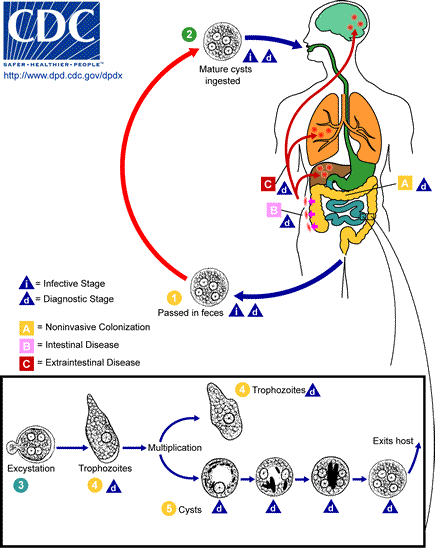| |
Cysts are passed in
feces
 .
Infection by Entamoeba histolytica occurs by ingestion of mature
cysts .
Infection by Entamoeba histolytica occurs by ingestion of mature
cysts  in
fecally contaminated food, water, or hands. Excystation in
fecally contaminated food, water, or hands. Excystation
 occurs in the small intestine and trophozoites
occurs in the small intestine and trophozoites
 are released, which migrate to the large intestine. The trophozoites
multiply by binary fission and produce cysts
are released, which migrate to the large intestine. The trophozoites
multiply by binary fission and produce cysts
 ,
which are passed in the feces ,
which are passed in the feces
 .
Because of the protection conferred by their walls, the cysts can survive
days to weeks in the external environment and are responsible for
transmission. (Trophozoites can also be passed in diarrheal stools, but are
rapidly destroyed once outside the body, and if ingested would not survive
exposure to the gastric environment.) In many cases, the trophozoites
remain confined to the intestinal lumen ( .
Because of the protection conferred by their walls, the cysts can survive
days to weeks in the external environment and are responsible for
transmission. (Trophozoites can also be passed in diarrheal stools, but are
rapidly destroyed once outside the body, and if ingested would not survive
exposure to the gastric environment.) In many cases, the trophozoites
remain confined to the intestinal lumen ( :
noninvasive infection) of individuals who are asymptomatic carriers, passing
cysts in their stool. In some patients the trophozoites invade the
intestinal mucosa ( :
noninvasive infection) of individuals who are asymptomatic carriers, passing
cysts in their stool. In some patients the trophozoites invade the
intestinal mucosa ( :
intestinal disease), or, through the bloodstream, extraintestinal sites such
as the liver, brain, and lungs ( :
intestinal disease), or, through the bloodstream, extraintestinal sites such
as the liver, brain, and lungs ( :
extraintestinal disease), with resultant pathologic manifestations. It has
been established that the invasive and noninvasive forms represent two
separate species, respectively E. histolytica and E. dispar,
however not all persons infected with E. histolytica will have
invasive disease. These two species are morphologically indistinguishable.
Transmission can also occur through fecal exposure during sexual contact (in
which case not only cysts, but also trophozoites could prove infective). :
extraintestinal disease), with resultant pathologic manifestations. It has
been established that the invasive and noninvasive forms represent two
separate species, respectively E. histolytica and E. dispar,
however not all persons infected with E. histolytica will have
invasive disease. These two species are morphologically indistinguishable.
Transmission can also occur through fecal exposure during sexual contact (in
which case not only cysts, but also trophozoites could prove infective). |
|
